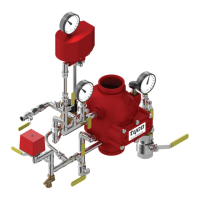TFP1090
Page 9 of 20
Valve Setting
Procedure
Perform this procedure when initially
setting the Model DPV-1 Dry Pipe
Valve; after an operational test of the
fire protection system; or, after system
operation due to a fire.
Refer to Figures 7 through 14 as appli-
cable for the given riser arrangement
and proceed as follows:
Step 1. Close the Main Control Valve,
and close the Air Supply Control Valve.
If the Model DPV-1 Dry Pipe Valve is
equipped with a Dry Pipe Valve Accel-
erator, close the Accelerator Control
Valve.
Step 2. Open the Main Drain Valve
and all auxiliary drains in the system.
Close the auxiliary drain valves after
water ceases to discharge. Leave the
Main Drain Valve open.
Step 3. As applicable, place the
Three-Way Alarm Control Valve in the
open position.
Step 4. Verify that the Automatic Drain
Valve has stopped draining to deter-
mine the Model DPV-1 Valve is com-
pletely drained.
Step 5. As necessary, replace all
sprinklers that have operated. Replace-
ment sprinklers must be of the same
type and temperature rating as those
which have operated.
NOTICE
In order to prevent the possibility of
a subsequent operation of an over-
heated solder type sprinkler, any solder
type sprinklers which were possibly
exposed to a temperature greater than
their maximum rated ambient must be
replaced.
Step 6. Push down on the Reset Knob
(Figure 3E) to allow the Clapper Assem-
bly to reseat.
Step 7. Pressurize the system with
air (or nitrogen) to 0,7 bar, and then
individually open all auxiliary drain
valves in the system piping to drain
any remaining water in trapped sec-
tions. Close each drain valve as soon
as water ceases to discharge. Also par-
tially open the Low Body Drain Valve in
the valve trim to assure that the riser
is completely drained. Close the Low
Body Drain Valve as soon as water
ceases to discharge.
Step 8. Refer to Table B and then
restore the system to the normal sys-
tem air pressure as necessary to hold
the Model DPV-1 Valve closed.
Step 9. Verify that there is not any air
discharging from the Automatic Drain
Valve.
The absence of air discharging from
the Automatic Drain Valve is an indica-
tion of a properly set air seat within the
Model DPV-1 Valve. If air is discharg-
ing, refer to the Care and Maintenance
section under Automatic Drain Valve
Inspection to determine/correct the
cause of the leakage problem.
Step 10. If the Model DPV-1 is
equipped with a Dry Pipe Valve Accel-
erator, reset the Dry Pipe Valve Accel-
erator in accordance with Steps 10A
through 10H. Otherwise, proceed to
Step 11.
Step 10A. While holding the plunger
of the Automatic Drain Valve
depressed, open the Accelera-
tor Control Valve one-quarter turn
and allow the water in the Acceler-
ator piping to blow out. After water
spray stops discharging, close the
Accelerator Control Valve and then
release the plunger.
Step 10B. Slowly remove the Vent
Plug located in the front of the Accel-
erator Cover and bleed off any resid-
ual air pressure in the Differential
Chamber.
Step 10C. Unscrew (counter-clock-
wise rotation) the knurled Reset
Knob at the front of the Accelera-
tor until it resists further turning. A
click, which is the sound of the Lever
snapping back into the Set Position,
may be heard. Screw the Reset Knob
back in until it is finger tight.
NOTICE
Do not wrench on the Reset Knob,
since damage may result. The Reset
Knob will turn with finger torque only.
1/4" NPT GAUGE
CONNECTION
DIFFERENTIAL
CHAMBER
RESTRICTION
SPRING
BALL FLOAT
1/2" NPT INLET
PILOT CHAMBER
INLET PORT
INLET CHAMBER
PILOT
CHAMBER
OUTLET
RELIEF VALVE
ANTI-FLOOD
VALVE
LEVER
LATCH
RELIEF PORT
FROM
SYSTEM
PIPING
TO DRY PIPE VALVE
INTERMEDIATE
FIGURE 5
MODEL ACC-1 DRY PIPE VALVE ACCELERATOR
IN SET POSITION
FIGURE 6
MODEL ACC-1 DRY PIPE VALVE ACCELERATOR
IN TRIPPED POSITION

